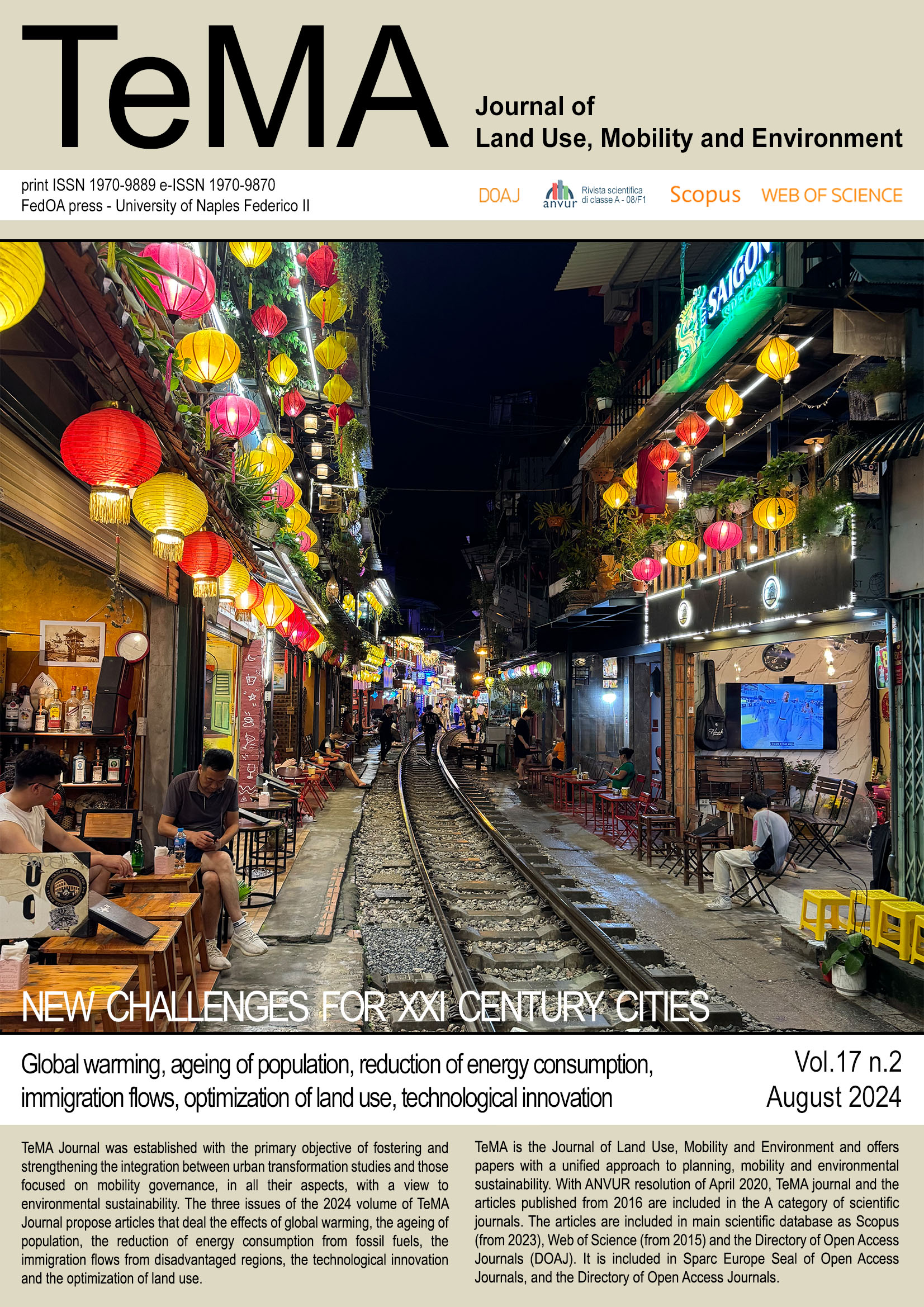Strategies and instruments for active mobility: a European overview
Abstract
Starting from the relationship between urban planning and mobility management, TeMA has gradually expanded the view of the covered topics, always remaining in the groove of rigorous scientific in-depth analysis. This section of the Journal, Review Notes, is the expression of continuously updating emerging topics concerning relationships between urban planning, mobility and environment, through a collection of short scientific papers written by young researchers. The Review Notes are made of four parts. Each section examines a specific aspect of the broader information storage within the main interests of TeMA Journal. In particular, the Urban strategies, programmers and tools section presents the different strategies and tools for active mobility implemented internationally.
The purpose of this review is to provide an overview of the instruments and strategies implemented in Europe to encourage active mobility. In addition, some solutions to promote active transport implemented in several European cities have been reported. These initiatives represent an opportunity for European communities to act in a necessary, indispensable and continuous process of improving urban mobility in the direction of environmental sustainability.
These measures, enhanced by dedicated tools such as SUMPs, promote behavioral change and support
mobility planning, setting active mobility as a winning strategy to improve city life and urban efficiency.
Downloads
References
Bruxelles Mobilité (2021). Good Move. Plan régional de mobilité 2020-2030 of the Brussels-Capital Region. Retrieved from: https://mobilite-mobiliteit.brussels/sites/default/files/2021-04/goodmove_FR_20210420.pdf
D’Amico, A. (2023a). New frontiers for sustainable mobility: MaaS (Mobility as a Service). TeMA - Journal of Land Use, Mobility and Environment, 16 (2), 455-460. http://dx.doi.org/10.6093/1970-9870/10039
D’Amico, A. (2023b). Urban spaces and pedestrian mobility: the role of urban design for enhancing walkability. TeMA - Journal of Land Use, Mobility and Environment, 16 (3), 639-644. Retrieved from: http://dx.doi.org/10.6093/1970-9870/10327
D’Amico, A. (2024). Strategies and instruments for active mobility: comparison of international experiences. TeMA - Journal of Land Use, Mobility and Environment, 17 (1), 155-167. http://dx.doi.org/10.6093/1970-9870/10771
EC (2020). COMMUNICATION FROM THE COMMISSION TO THE EUROPEAN PARLIAMENT, THE COUNCIL, THE EUROPEAN ECONOMIC AND SOCIAL COMMITTEE AND THE COMMITTEE OF THE REGIONS Sustainable and Smart Mobility Strategy – putting European transport on track for the future. COM/2020/789 final. Retrieved from: https://eur-lex.europa.eu/legal-content/EN/TXT/?uri=CELEX%3A52020DC0789
EC (2022). Retrieved from: https://transport.ec.europa.eu/system/files/2022-12/2022%20New%20Mobility%20Patterns% 20in%20European%20Cities%20Task%20A%20Executive%20summary.pdf
EU Urban Mobility Observatory (2020). Brussels: promoting walking and cycling as a priority in urban mobility. Retrieved from: https://urban-mobility-observatory.transport.ec.europa.eu/resources/case-studies/brussels-promoting-walking-and-cycling-priority-urban-mobility_en?prefLang=it
EU Urban Mobility Observatory (2021). Oslo – Promoting Active Transport Modes. Retrieved from: https://urban-mobility-observatory.transport.ec.europa.eu/resources/case-studies/oslo-promoting-active-transport-modes_en?prefLang=it&etrans=it
EU Urban Mobility Observatory (2023a). Sofia’s SUMP 2019-2035: Addressing Urban Mobility Challenges. Retrieved from: https://urban-mobility-observatory.transport.ec.europa.eu/resources/case-studies/sofias-sump-2019-2035-addressing-urban-mobility-challenges_en?prefLang=it
EU Urban Mobility Observatory (2023b). Brussels City 30 – changing the mobility model for a calmer city with safe roads and less noise. Retrieved from: https://urban-mobility-observatory.transport.ec.europa.eu/resources/case-studies/brussels-city-30-changing-mobility-model-calmer-city-safe-roads-and-less-noise_en?prefLang=it
Eurocities (2021). Cycling and walking – Madrid on the move. Retrieved from: https://eurocities.eu/latest/cycling-and-walking-madrid-on-the-move/
Eurostat (2022). Urban-rural Europe – introduction. Retrieved from: https://ec.europa.eu/eurostat/statistics-explained/ index.php?oldid=587819
ITDP (2023). Paris, France Honored with the 2023 Sustainable Transport Awar. Retrieved from: https://itdp.org/2023 /01/10/paris-2023-sustainable-transport-award/
Madrid 360 (2019). Avance de la Estrategia de Sostenibilidad Ambiental-Madrid-360. Retrieved from: https://www.madrid360.es/wp-content/uploads/2021/09/Avance-Estrategia-Sostenibilidad-Ambiental-Madrid-360_baja.pdf
Martinelli, V. (2024). New trends in energy transition policies: citizens' involvement in the European energy market. TeMA - Journal of Land Use, Mobility and Environment, 17 (1), 147-153. http://dx.doi.org/10.6093/1970-9870/10772
Pellicelli, G., Rossetti, S., Caselli, B. & Zazzi, M. (2022). Urban regeneration to enhance sustainable mobility. TeMA - Journal of Land Use, Mobility and Environment, 57-70. https://doi.org/10.6093/1970-9870/8646
Plan Vélo-Ville de Paris (2021). Paris 100% cyclable. Plan Vélo 2021-2026. Retrieved from: https://cdn.paris.fr/paris/ 2021/11/18/80f9fd1e6d5012e0a4a9820bd6adfd56.pdf
Statista Research Department (2023). Leading cities in Europe scored by the availability of space for people walking and cycling in 2022. Retrieved from: https://www.statista.com/statistics/1405935/european-cities-ranked-by-space-for-people-walking-and-cycling/#statisticContainer
Copyright (c) 2024 TeMA - Journal of Land Use, Mobility and Environment

This work is licensed under a Creative Commons Attribution 4.0 International License.
Authors who publish in this journal agree to the following:
1. Authors retain the rights to their work and give in to the journal the right of first publication of the work simultaneously licensed under a Creative Commons License - Attribution that allows others to share the work indicating the authorship and the initial publication in this journal.
2. Authors can adhere to other agreements of non-exclusive license for the distribution of the published version of the work (ex. To deposit it in an institutional repository or to publish it in a monography), provided to indicate that the document was first published in this journal.
3. Authors can distribute their work online (ex. In institutional repositories or in their website) prior to and during the submission process, as it can lead to productive exchanges and it can increase the quotations of the published work (See The Effect of Open Access)

